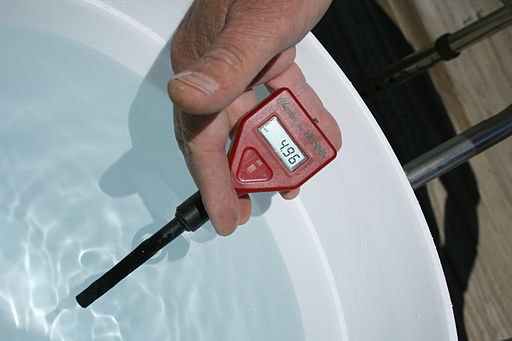7.7: pH Calculations, pH measurement, and pH estimation
- Page ID
- 221513
Calculations involving proton (H+) (or hydronium ion,H3O+ ) concentrations are generally done using logarithms. Recall that a logarithm is simply the exponent that some base number needs to be raised to in order to generate a given number. In these calculations, we will use a base of 10. A number such as 10,000 can be written as 104, so by the definition, the logarithm of 104 is simply 4. For a small number such as 10-7, the logarithm is again simply the exponent, or -7.
There is one other convention that chemists apply when they are dealing with logarithms of hydronium ion concentrations, that is, the logarithm is multiplied by (-1) to change its sign. Why would we do this? In most aqueous solutions, [H+] will vary between 10-1 and 10-13 M, giving logarithms of –1 to –13. To make these numbers easier to work with, we take the negative of the logarithm (-log[H+]) and call it a pH value. The use of the lower-case “p” reminds us that we have taken the negative of the logarithm, and the upper-case “H” tells us that we are referring to the hydronium ion concentration. Converting a hydronium ion concentration to a pH value is simple. Suppose you have a solution where [H+] = 3.46 × 10-4 M and you want to know the corresponding pH value. You would enter 3.46 × 10-4 into your calculator and press the LOG button. The display should read “-3.460923901”. First, we multiply this by (-1) and get 3.460923901. Next, we examine the number of significant figures. Our experimental number, 3.46 × 10-4 has three significant figures, so our mantissa must have three digits. We round our answer and express our result as, pH = 3.461.
The reverse process is equally simple. If you are given a pH value of 7.04 and are asked to calculate a hydronium ion concentration, you would first multiply the pH value by (-1) to give –7.04. Enter this in your calculator and then press the key (or key combination) to calculate “10x”; your display should read “9.120108 × 10–8”. There are only two digits in our original mantissa (7.04) so we must round this to two significant figures, or [H3O+] = 9.1 × 10-8.
Exercise \(\PageIndex{1}\)
Calculating [H3O+] and pH Values
- A solution is known to have a proton (hydronium ion) concentration of 4.5 ×10-5 M; what is the pH this solution?
- A solution is known to have a pH of 9.553; what is the concentration of hydronium ion in this solution?
- A solution is known to have a hydronium ion concentration of 9.5 ×10-8 M; what is the pH this solution?
- A solution is known to have a pH of 4.57; what is the hydronium ion concentration of this solution?
There is another useful calculation that we can do by combining what we know about pH and expression
\[K_{W}=[H^{+}][HO^{-}]\]
We know that KW = 10-14 and we know that (-log [H3O+]) is pH. If we define (-log [HO–]) as pOH, we can take our expression for KW and take the (-log) of both sides (remember, algebraically you can perform the same operation on both sides of an equation) we get:
\[K_{W}=10^{-14}=[H^{+}][HO^{-}]\]
\[-\log (10^{-14})=(-\log [H^{+}])+(-\log [HO^{-}])\]
\[14=pH+pOH\]
Which tells us that the values of pH and pOH must always add up to give 14! Thus, if the pH is 3.5, the pOH must be 14 – 3.5 = 11.5. This relationship is quite useful as it allows you to quickly convert between pH and pOH, and therefore between [H3O+] and [HO–].
The simplest way to measure the pH of a solution is to use an electronic pH meter. A pH meter is actually a sensitive millivolt meter that measures the potential across a thin, sensitive glass electrode that is immersed in the solution. The voltage that develops is a direct function of the pH of the solution and the circuitry is calibrated so that the voltage is directly converted into the equivalent of a pH value. You will most likely use a simple pH meter in the laboratory. The thing to remember is that the sensing electrode has a very thin, fragile, glass membrane and is somewhat expensive to replace. Be careful!
A simple pH meter. Image by Ildar Sagdejev (Specious), CC BY-SA 4.0, via Wikimedia Commons.
A simple way to estimate the pH of a solution is by using an indicator. A pH indicator (see section 7.21: Indicators) is a compound that undergoes a change in color at a certain pH value. For example, phenolphthalein is a commonly used indicator that is colorless at pH values below 9, but is pink at pH 10 and above (at very high pH it becomes colorless again). In the laboratory, a small amount of phenolphthalein is added to a solution at low pH and then a base is slowly added to achieve neutrality. When the phenolphthalein changes from colorless to pink, you know that enough base has been added to neutralize all of the acid that is present. In reality, the transition occurs at pH 9.2, not pH 7, so the resulting solution is actually slightly alkaline, but the additional hydroxide ion concentration at pH 9 (10-5 M) is generally insignificant relative to the concentrations of the solutions being tested.
Another convenient way to estimate the pH of a solution is to use pH paper. This is simply a strip of paper that has a mixture of indicators embedded in it. The indicators are chosen so that the paper takes on a slightly different color over a range of pH values. The simplest pH paper is litmus paper that changes from pink to blue as a solution goes from acid to base. Other pH papers are more exotic. In the laboratory, you will use both indicators, like phenolphthalein, and pH papers in neutralization experiments called titrations.
Contributor
- ContribEEWikibooks


